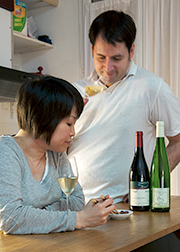What sets Sauvignon Blanc apart from almost every other white grape variety? In a word: methoxypyrazines, though you may better know this aroma molecule under descriptors such as gooseberry, green grass, bell pepper, tomato stems, burgeoning black current, or even cat pee! We all associate this scent with different things, but what it comes down to is that Sauvignon Blanc’s signature aroma presents an immediately recognizable green, herbal character which does wonders for food pairings, and Japanese cuisine is no exception.
Light Sauvignon Blanc
While it may not sound too appetizing, green, grassy aromas generally give these light-bodied whites a pleasant refreshing twist which goes well with the relatively lively acidity. More importantly, Sauvignon Blanc’s green notes are in the forefront, which allows for food pairings which would put any other wine in difficulty, and it is this strength which we will draw on to match some popular Japanese vegetables such as negi (scallion), shisou leaf or asparagus. As tempting as it may sound however, stay away from bell peppers, as the aromas become just too pungeant.
Best pairings: tempura (asparagus, shisou leaf, okra), asparagus & bacon kushiyaki, tebasaki yakitori (w/out tare), tako-wasabi (raw octopus in wasabi)
$ : Quincy, Menetou-Salon, Chile (Casablanca, Leyda)
$ – $$ : South Africa (Constantia, Elgin), Austria (Südsteiermark)
Fruity Sauvignon Blanc
Of course, one cannot reduce this widely popular and divers grape variety to its herbal character. Fruitier wines made from this grape present intense citrus aromas of grapefruit as well as distinct passion fruit notes when grown in warmer climates, such as New Zealand. Generally, these wines will pair better with flavorful dishes than a light herbal Sauvignon, as they offer more weight and concentration on the palate.
Best Pairings: negima yakitori w/ tare, negitoro-don, ponzu
$ : Touraine, Bordeaux Blanc, Entre-Deux-Mers
$ – $$ : California “Sauvignon Blanc”
$$ : New Zealand (Marlborough)
Mineral Sauvignon Blanc
The Sauvignon Blanc wines of Sancerre and Pouilly-Fumé in the Loire Valley remain the French ambassadors of this grape variety, and are priced accordingly. They are crisp dry wines with a wonderful flinty minerality which pairs very nicely with seafood and more delicate dishes. Saint-Bris is another interesting option, as the grapes are grown in the Chablis area and offer a similar expression despite the different grape variety.
Best pairings: tempura, ten-don (tempura on rice), also see mineral whites.
$$ : Sancerre, Pouilly-Fumé
NOTE: Naturally, mineral examples of Sauvignon Blanc can be found in other regions of the world, but wines from the above mentioned appellations are more likely to be made in this style.
Oaked Sauvignon Blanc
With prolonged oak maturation, Sauvignon Blanc wines take on a creamy texture with a more integrated acidity. This gives the wine a little more weight and roundness and opens up new possibilities for food pairings, particularly boiled meat and vegetable nabe, or grilled/teppan dishes involving tare sauce. Nutty or buttery aromas from the oak aging on lees shouldn’t be too overt, but can still add a nice touch for grilled fish or white meats.
Best pairings: yosenabe, pork shabu-shabu w/ sesame dipping sauce, okonomiyaki, yakisoba
$-$$ : California “Fumé Blanc”, Graves
$$ : Pessac-Léognan, certain high end Sancerre or Pouilly-Fumé (A. Mellot, Bourgeois, etc.)





